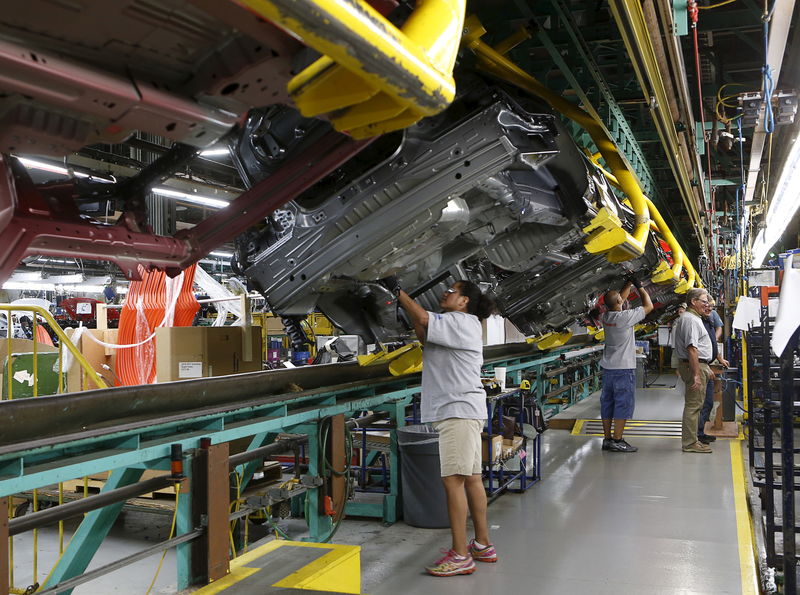By Lucia Mutikani
WASHINGTON (Reuters) - U.S. manufacturing output rose for a fifth straight month in October, shrugging off a sharp drop in motor vehicle production and suggesting underlying strength in factory activity despite growing headwinds that are expected to slow the sector in 2019.
The Federal Reserve said on Friday manufacturing production rose 0.3 percent last month. Data for September was revised up to show output at factories increasing 0.3 percent instead of advancing 0.2 percent as previously reported.
Economists polled by Reuters had forecast manufacturing output rising 0.2 percent in October. Manufacturing, which accounts for more than 12 percent of the economy, is expected to slow down next year in part as the stimulus from the Trump's administration's $1.5 trillion tax cut package fades.
Manufacturing surveys have suggested a moderation in factory activity amid labor shortages as well as more expensive raw materials caused by the White House's protectionist trade policy.
A strong dollar, which has gained about 8.1 percent this year against the currencies of the United States' main trade partners, is also hurting exports, and there are signs of slowing growth in other economies, including China.
"The manufacturing sector is still coping fairly well with the dollar's recent appreciation and the slowdown in global growth," said Andrew Hunter, a U.S. economist at Capital Economics in London.
"But the recent weakening in the global manufacturing PMIs, particularly in China, suggests that the current strength of the factory sector is unlikely to be sustained," Hunter said, referring to purchasing managers' indexes.
U.S. financial markets were little moved by the data, with traders focused on worries about a slowing global economy. The dollar (DXY) fell against a basket of currencies, while U.S. Treasury prices rose. Stocks on Wall Street were trading lower.
AUTO PRODUCTION SLUMPS
Motor vehicle production slumped 2.8 percent in October after rising 1.3 percent in September. Economists blamed the drop on U.S. tariffs on imported steel and aluminum, and warned of further harm to production if the duties were not scrapped.
"While automakers have successfully countered industry headwinds, such as tighter bank lending for autos, U.S. import tariffs on steel and aluminum continue to pose downside risks amid late-cycle demand fatigue," said Stephen Ciccarella, a senior economist at Moody's Analytics in West Chester, Pennsylvania.
Excluding motor vehicles and parts, manufacturing gained a solid 0.5 percent last month, boosted by a strong increase in the output of business equipment. That followed a 0.2 percent rise in September.
Business equipment production increased 0.8 percent, matching September's rise. The strong gains suggest a pickup in business spending on equipment in the fourth quarter after it stalled in the July-September period.
October's rise in manufacturing production offset decreases in mining and utilities output, leading to a 0.1 percent gain in industrial production last month. Industrial output rose 0.2 percent in September.
The Fed said Hurricanes Florence and Michael had lowered the level of industrial production in both September and October, but the effects of the storms "appear to be less than 0.1 percent per month."
Mining output fell 0.3 percent in October after slipping 0.1 percent in September. Oil and gas well drilling rebounded 1.6 percent after declining for three straight months. With oil prices dropping to an eight-month low on Tuesday, economists expect mining production to remain weak.
"Given the steep declines in oil prices since early October, these declines in mining activity are likely to gather momentum in the coming months," said Jonathan Millar, an economist at Barclays (LON:BARC) in New York.
Utilities output dropped 0.5 percent in October after dipping 0.1 percent in the prior month.
Capacity utilization for the manufacturing sector, a measure of how fully firms are using their resources, rose to 76.2 percent in October, the highest since July 2015, from 76.1 percent in September.
Overall capacity use for the industrial sector fell to 78.4 percent from 78.5 in September. It is 1.4 percentage points below its 1972-to-2017 average.
Officials at the Fed tend to look at capacity use measures for signals of how much "slack" remains in the economy — how far growth has room to run before it becomes inflationary.
